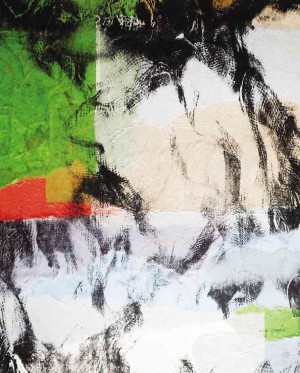
Regarded as “the most tempestuous” piano work by Ludwig Van Beethoven is his Sonata No. 23, popularly known as the Appassionata. The word is Italian for “passionate.”
Five artists also chose Appassionata as the title of their group exhibition on view at the Altro Mondo Gallery in Greenbelt 5, Makati. All ardent and brimming with passion for life and art are Rosario Bitanga, Imelda Cajipe-Endaya, Lenore RS Lim, Susan Fetalvero Roces and Marivic Rufino. The show is curated by Deanna Ongpin-Recto.
To be sure, the show is more than just female bonding, but a coming together of diverse talents and temperaments, united by an impassioned, lifetime commitment to their artistry.
“Appassionata” is their own tempest of creation.
The works of Susan Fetalvero Roces remind the viewer that they are sustained by personal references, even if not directly autobiographical. As artworks they are an integration of the artist’s consuming interests, fascinations, and technical skills.
Recall that Roces was once a vaunted abstractionist whose works merited praise from the late National Artist J. Elizalde Navarro. Innovation in the use of material distinguished her works. Roces’ use of raffia was a display of stunning sophistication, tapping into nature and a free spirit.
Her recent works, “Viajes de Vida,” is a sculptural piece that consists of boat paddles. Isolated from the context of their usage, they evoke an abstract feeling that hews to Minimalism’s spare and stark aesthetics. The artist, however, reflects on these paddles as instruments of voyages and journeys. She intuits the swift passages of her life as though it were a continuously running river.
“Masks” seduces us with these instruments of camouflage. Beyond their ornamental exhilaration and gorgeousness, these masks, obviously channeled as a collector’s delight, hold remarkably symbolic connotations for the artist.
Watercolor has been a favored medium with Rufino, and for good reason: the liquid flowing of colors, seemingly denuded of body and volume as with acrylics and oils, is a lucid transparency of her spirit and feelings.
A collection of her book-bound images has inspired the poetry of National Artist Virgilio Almario. It is aptly titled “Romanza” and beguiles the viewer with shades and shadows of muted colors—even the fiery reds and oranges seem ecstatically bleached. Her “Dreamscape” series are tranquil journeys of the spirit, recoiling from the obstreperous blandishments of gaudy and raucous hues.
Rufino’s recent works are imbued with a Zen sensibility. To be sure, the artist has always invoked a contemplative psyche and the intimacy of memory. Ostensibly these are depicted landscapes. Such works as “Tuscan Reverie,” “Tuscan Dream” and “Paradiso,” though anchored by allusions to trees and hills, skies and seas, are paradoxically metaphors for spiritual vistas.
Bitanga
Like National Artists Arturo Luz and J. ELizalde Navarro, Bitanga is one of the rare few who are adept at both painting and sculpture, enriching the vision of one with the other, not in a gratuitous manner, but with passionate fealty, attending to both with equal seriousness.
Her sculptures are exemplars of “drawing in space,” not in the linear mode, to be sure, but planar, as evinced by her gleaming sheets of stainless steel, as though liberated from the flatness of the canvas.
In her sculptures, Bitanga’s handling of materials—the favored terra cotta, resin bases and stainless steel—is emblematic of her refined and exquisite eye for expressive design. “Nurture” is a variant of the family triad theme, brought to an elegant elongation of proportions. A work in stainless steel, “Dewdrop,” is a finely shaped metal sheet configured to suggest a leaf. A gleaming glass orb is an object-distillation of dew. “Tesseract” is the visual analogue of the fourth dimension—the time-space continuum.
But whether in painting or sculpture, Bitanga adheres to the same qualities she has always upheld: “discipline, control in emotion and composition; order, neatness, serenity.” Lyd Arguilla Salas, founder of the historical Philippine Art Gallery (PAG) extolled Bitanga as “a first rate artist!”
Endaya first gained recognition as a printmaker. Her most notable series was titled “Ninuno” (Ancestors) which made use of images of ancient Filipinos as gleaned from the Boxer Codex and the 19th-century artist Damian Domingo’s albums of costumes. Thus she made her mark as a historically conscious artist intent on making serious visual statements, during an era that was being convulsed by a radically changing social and political climate.
The succeeding decades saw Endaya confronting a harsher reality, which demanded a medium capacious enough to contain her seething, simmering themes. Through her assemblages and installations Endaya explored in depth such themes as race and cultural identity, gender issues, women’s rights, social inequality and the plight of Filipino domestics as the uniformed slaves to the First World.
Endaya’s “Happy Mother’s Day, Tandang Sora” is a poem to Melchora Aquino, revered by our history as the Mother of the Katipunan, who ministered to sick and wounded revolutionaries.
“Portrait of the Artist as Babaylan” is a self-portrait rendition of the artist in a drama-ritual that conflates the roles of healer, shaman and creator.
By channeling her own persona into other distinct historical female figures, Endaya’s art extends her feminism, reaching out into centuries past.
The current denigration of feminism is itself symptomatic of the anomie that afflicts contemporary art. True to character, Endaya is impervious to the fickleness of fashionable art and has remained staunchly committed to the cause of feminism as attested by her recent works.